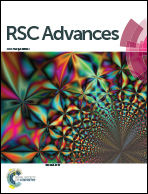BiOX/BiOY (X, Y = F, Cl, Br, I) superlattices for visible light photocatalysis applications
Abstract
The BiOX/BiOY (X, Y = F, Cl, Br, I, X ≠ Y) systems have been investigated as possible visible light photocatalysts in contrast with the BiOX (X = F, Cl, Br, I) systems by using hybrid density functional calculations. All the BiOX/BiOY systems have indirect bandgaps, and all the bandgaps of BiOX/BiOY systems we considered are between the bandgaps of BiOX and BiOY systems. The calculated bandgaps for BiOF/BiOCl, BiOF/BiOBr, BiOF/BiOI, BiOCl/BiOBr, BiOCl/BiOI, and BiOBr/BiOI are respectively 3.86, 3.41, 2.74, 2.99, 2.30, and 2.23 eV. The maximum absorption wavelength increases in the order of BiOF, BiOF/BiOCl, BiOCl, BiOF/BiOBr, BiOCl/BiOBr, BiOBr, BiOF/BiOI, BiOCl/BiOI, BiOBr/BiOI, and BiOI. The conduction band edges for all the BiOX/BiOY systems originate from Bi 6p states, but the valance band edges are contributed by different electronic states. Besides, the relative positions of X p states and Y p states for BiOX/BiOY systems are different, which should be attributed to the different p orbital energies of X and Y atoms. Due to the conduction band maximum is lower than the hydrogen reduction potential, all the BiOX and BiOX/BiOY systems are thermodynamically unfavorable for hydrogen production. Meanwhile, owing to the suitable bandgaps and band edge positions, the BiOF/BiOI, BiOCl/BiOBr, BiOCl/BiOI, and BiOBr/BiOI superlattices are possible visible light photocatalysts for degradation of organic pollutants.


 Please wait while we load your content...
Please wait while we load your content...